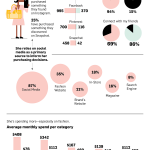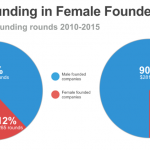These Are The Best And Worst Places In The U.S. To Be A Working Mother
The career challenges faced by working mothers are no big secret. Studies have shown that perceptions such as being more distracted and less goal-oriented compete with the exact opposite view of their male counterparts. No wonder there’s been a rise in the “fatherhood bonus” as the “motherhood penalty” continues to challenge career advancement, as well as financial equality. And the hurdles mount when mothers opt to start their own businesses. A new Kauffman report indicates these women face “increased work-family conflict, cognitive biases, and lack of mentorship and social capital.”
Is there hope?
First, the bad news. As Sheryl Sandberg recently observed, “”If NASA launched a person into space today, she could soar past Mars, travel all the way to Pluto, and return to Earth 10 times before women occupy half of C-suite offices.”
And although the earnings gap has closed substantially since the 1960s, a new report from U.S. Congress Joint Economic Committee (JEC) indicates that at the current rate of change, the gender pay gap will not close until 2059.
In addition to workplace challenges, Lisa Ellen Wolf-Wendel, a professor of higher education at the University of Kansas, points to gender inequity in the home. “Gendered norms,” she writes, “for both men and women are entrenched into our psyches. Not all families have equitable divisions of labor at home.”
But there are bright spots. A new report from WalletHub reveals working mom-friendly locations across the U.S. It’s particularly good news if you live and work in Vermont, Minnesota, or Connecticut, the three states identified by WalletHub’s analysts as home to the best environments for working mothers.
On the map below, states are ranked from dark to light with darker colors ranking higher. Click a state to see its rank by number.
To arrive at their rankings, analysts rated states for childcare (40 points), professional opportunities (30 points), and work-life balance (30 points). Within those three areas, they identified 13 metrics such as the quality of daycare and the cost of childcare, the gender-wage gap (which does vary by state), median salaries for women, parental leave policies, and the average length of a woman’s work week, among others.
Data for these metrics was drawn from the U.S. Census Bureau, Bureau of Labor Statistics, Child Care Aware of America, Equal Employment Opportunity Commission, Council for Community and Economic Research, National Partnership for Women & Families, and WalletHub’s own research.

While the aforementioned three states received the best overall scores, the analysts found that states that voted predominately Democratic in the 2012 election are more friendly to working mothers. Also, drilling down by each different metric shows that some locations have better services and compensation than others.
For example, Washington, D.C. and Hawaii have the lowest gender pay gaps (Utah and Wyoming have the highest). New York and Washington (state) have daycare systems that are five times better in terms of availability, cost, and quality, than those at the bottom of the list: California, Nebraska,and Idaho, but there’s a cost to quality. New York ranks close to the bottom for the highest prices for child care, D.C. and Florida are the worst. It may be that D.C.’s working mothers aren’t really benefitting from the narrow gender-wage gap in their area because they are just funneling their pay toward childcare.
Why do such inequities persist? Some experts such as Wolf-Wendel point to the fact that the modern American workplace is still not yet a fully gender equitable place. “In particular, not all employers or job classifications have recognized the different needs of men and women, nor do they all recognize the importance of work/family balance.”
Others, such as Laura Mattoon D’Amore, assistant professor of American Studies at Roger Williams University, note that childcare costs are still privatized, and still surpass rent and average college tuition in many states. Fast Company recently reported that was true in 33 states and Washington, D.C., a fact that in combination with lower wages, forces some women to quit their jobs rather than foot the bill for daycare.
To alleviate the burden and make the workplace more equitable, Ann Mastergeorge, a professor at Texas Tech University, believes the government should step in. “All states should be mandated to provide paid maternity and paternity leaves, childcare subsidies, and have workplace high-quality childcare available.”
Related: How The U.S. Almost Had Universal Child Care (Twice)
Until there are government mandates, the professors agree that employers should be more supportive of working families. Wolf-Wendel says that even though it’s the right thing to do, it’s not necessarily altruistic for employers. “Employers benefit from paying attention to work/life concerns for all of their employees,” she explains, “It helps with recruitment of the best and brightest, it helps with retention, and it helps with job productivity.”
Fast Company , Read Full Story
(20)














